2017 Honda Accord Hybrid
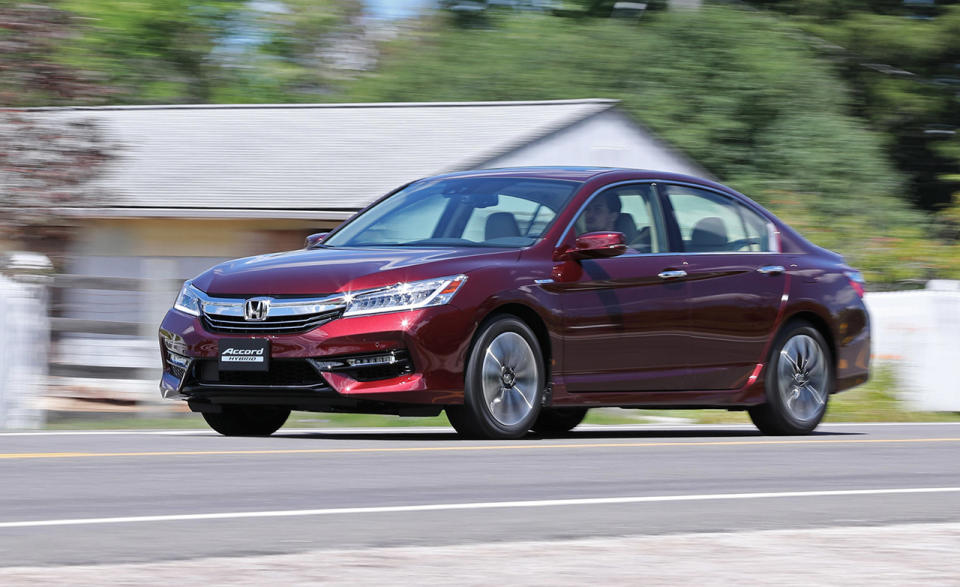
Numbers aren’t why we recommend the Honda Accord. This sedan instead has made our 10Best Cars list for years because it wows with its affordability, practicality, and comfort and then manages to include something visceral for those who like to drive. The Accord hybrid, however, which returns to production for 2017 after a year’s absence, doesn’t quite engender the same warm feelings.
However, any model that flaunts a hybrid badge really is a numbers car. With each dab of the brake and each lift of the accelerator, they recover precious watt-hours in an attempt to save thousands of gallons of fuel over the life of the vehicle—which can add up to serious dollars, particularly when today’s environment of cheap gasoline eventually comes to an end.
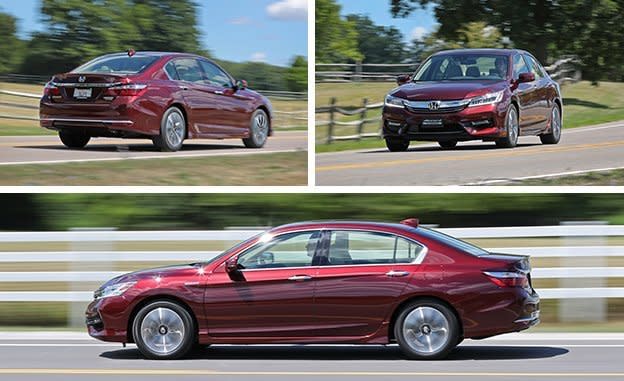
Even with hybrid versions of the Ford Fusion, Hyundai Sonata, Toyota Camry, and Chevrolet Malibu all now in the mix, the Accord hits some big-deal EPA mileage numbers: 49 mpg city, 47 highway, and 48 combined, with a peak output of 212 horsepower. These measures top those of many rivals.
Among all these alternatives, it’s a veritable proving ground of clever engineering approaches, and the Accord hybrid is the outlier in its class. It’s laid out almost as an electric car, with the four-cylinder engine turning an onboard generator—most of the time, that is.
No Transmission, Plenty of Shiftiness
The front-wheel-drive Accord hybrid eschews the transmission as we know it, instead using a clutch and two electric motor/generators. One motor is geared directly to an Atkinson-cycle, 2.0-liter four-cylinder engine—making 143 horsepower and 129 lb-ft of torque—with a clutch connecting them to the differential; the other motor is geared directly to the differential. This enables three distinct driving modes: an EV mode using only battery power, a Hybrid mode that uses electricity to propel the car with the gasoline engine powering the generator, and a more elusive Engine Drive mode employed between approximately 44 mph and 75 mph under certain conditions, during which it will clutch the gasoline engine in at a fixed ratio. (Major hipster cred: You’ll have the only electric-gasoline fixie outside of a Koenigsegg Regera.)
Drive moderately, and there’s confident response when you tip into the accelerator and a nice, linear feel to the acceleration—more linear in the lower sweep of the speedometer than you get in the conventional, four-cylinder/CVT model, thanks to the electric motor’s instant torque. Even with a moderate prod of the accelerator, the Accord hybrid launches confidently using only the motor. The gasoline engine typically fires up by about 20 mph but is quick to shut down as soon as city cruising speeds are reached. If you’re gliding along at a steady 55 mph, the Accord hybrid’s system cycles the engine off for a half-mile or more at a time, combining power sources once again only until you get to the next downhill stretch.
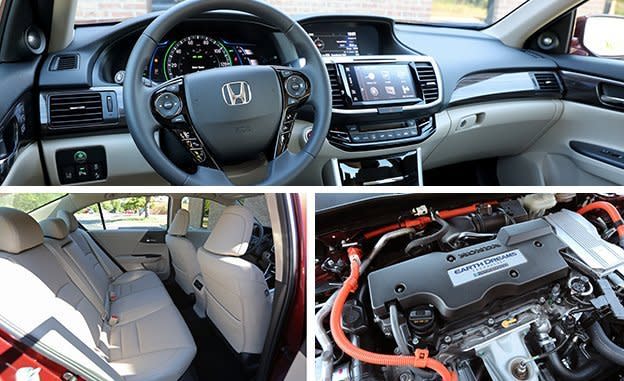
The less delightful side of the powertrain emerges as soon as you decide not to drive the Accord as a moderate and mindful hybrid owner. When you ask more of this powertrain, the engine buzzes in its upper rev reaches to keep up with the motor’s electricity demands. In a situation where the four-cylinder/CVT Accord would be settled and steady, like a 70-mph freeway cruise, the Accord hybrid is perceptibly busy, as even in that Engine Drive mode the system will grab spare energy from the generator, draft the propulsion motor for some light assist, and occasionally shut off the gas engine for short stints.
Quick Enough for the Mission
There may be a whole lot going on, but by the numbers the hybrid is the clear winner over the Accord with the four-cylinder and the continuously variable automatic transmission. Although it carried 208 pounds more mass than the last four-cylinder Accord we tested, the hybrid is nearly a half-second quicker to 60 mph. Compared with previous hybrid Accords, Honda has recalibrated the brakes with less boost at the top of the pedal travel but more when you stand on it. It feels more linear, but the pedal remains on the squishy side. Its stopping distance from 70 mph (195 feet) also is significantly longer than those of the nonhybrid Accords. However, the hybrid pulls a reasonable 0.81 g on the skidpad despite the vocal protestations of its Michelin Energy Saver A/S tires.
The Accord hybrid doesn’t include paddle shifters, and there’s really no attempt to feign sportiness—other than a Sport mode that merely ratchets up accelerator response and a “B” shift mode that increases regenerative braking. Yet the Accord hybrid is easy to hustle and downright graceful on back roads, with new dampers helping to provide a smooth ride, a suspension that loads up quickly and predictably, and accurate steering that lets you dial in the right amount of input the first time. Yet that grace is juxtaposed against the groaning soundtrack coming from under the hood and the feeling that the hybrid system is going to respond just a little bit differently from moment to moment.
Honda engineers reworked the car’s core hybrid-system hardware for 2017. A higher-performance motor/generator sees its output boosted by 15 horsepower, with peak torque up 6 lb-ft to 232. A lighter-weight power-control unit mounts directly on the transmission. The battery pack is smaller, with a lighter and smaller DC-DC converter, an integral battery-control unit, and more efficient cooling. Inner-fender air slits and reshaped bumper corners reduce aerodynamic drag.
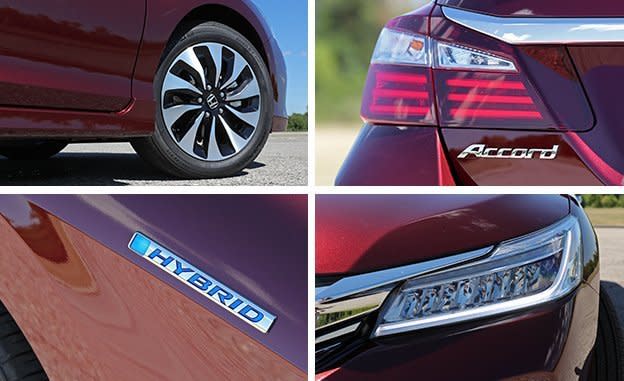
Compared with Accord hybrids we’ve tested in the past, the performance improvements were inconsistent. The 2017 model was 0.2 second quicker from 5 to 60 mph (7.4 seconds) and from 50 to 70 mph (5.2 seconds) versus the 2014 model, yet it was 0.5 second slower from 30 to 50 mph (at 4.0 seconds). Compared with the standard four-cylinder Accord, however, the hybrid feels quicker, and nearly all objective measures confirm that impression.
All that said, the hybrid number that matters most is fuel economy, and we didn’t get anything close to the impressive EPA numbers. Instead, we averaged 35 mpg—a whopping 13 mpg shy of the EPA combined rating. In the Accord Touring four-cylinder, by comparison, we averaged 30 mpg, just 1 mpg below its 31-mpg EPA combined number. Cruising at a steady 75 mph on the highway, we measured a more palatable 45 mpg.
Built for a Specific Usage Case
Hybrids are for a time and a place, and the current time is a challenging one for this entire class. When the Accord hybrid went on sale in 2014, gas prices had surged toward $3.70 a gallon nationally and were well over $4 a gallon in California. Demand was strong, but the factory couldn’t supply enough cars to keep up (citing supply-chain issues with the battery and electric-drive components). Now Honda has that fixed, in part by moving production from Ohio to Japan (and dropping the even more confounding Accord plug-in hybrid from the lineup). And while Honda retains its original sales target of 30,000 vehicles a year, gas prices are far lower than they were when the previous car first went on sale.
And as for the place, our Michigan test conditions—of fast-moving freeways, stoplight-lined boulevards, and two-lane country back roads—seem far from those for which the Accord hybrid was designed. Its bias toward electric propulsion would excel in the sort of gridlock commuter crawl you might encounter in cities like Los Angeles, San Francisco, or Washington, D.C.
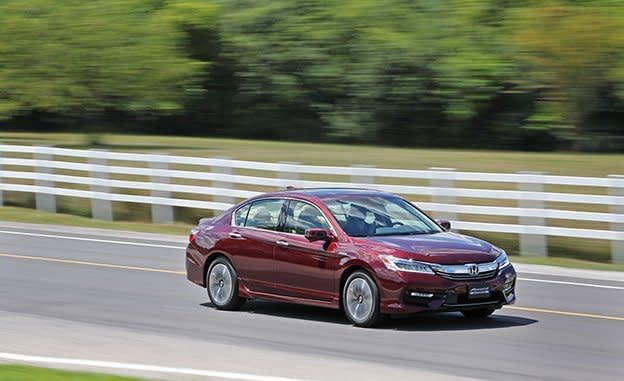
The Accord hybrid is sold as the top-level model of the Accord lineup, which means it’s expensive. The as-tested price on our Touring version was $36,790, which included leather upholstery, adaptive cruise control, and navigation. The hybrid adopts most of the changes given to the rest of the Accord sedan lineup last year, including a sharpened front-end look, tidier rear styling, revamped interior trims and finishes, Honda Sensing active-safety gear, and, for all but the base model, Apple CarPlay and Android Auto.
Ultimately, the hybrid may hit the power-versus-efficiency sweet spot, but it isn’t the sweetheart in the broader Accord lineup. It’s the one you accept for the daily drive, when it’s most definitely going to be a grind.
Specifications >
VEHICLE TYPE: front-engine, front-wheel-drive, 5-passenger, 4-door sedan
PRICE AS TESTED: $36,790 (base price: $30,440)
ENGINE TYPE: DOHC 16-valve Atkinson-cycle 2.0-liter inline-4, 143 hp, 129 lb-ft; permanent-magnet synchronous AC motor, 181 hp, 232 lb-ft; combined power rating, 212 hp; 1.3-kWh lithium-ion battery pack
TRANSMISSION: 1-speed direct drive
DIMENSIONS:
Wheelbase: 109.3 in
Length: 194.1 in
Width: 72.8 in Height: 57.5 in
Passenger volume: 101–103 cu ft
Cargo volume: 14 cu ft
Curb weight: 3533 lb
C/D TEST RESULTS:
Zero to 60 mph: 7.2 sec
Zero to 100 mph: 21.1 sec
Zero to 110 mph: 27.6 sec
Rolling start, 5–60 mph: 7.4 sec
Top gear, 30–50 mph: 4.0 sec
Top gear, 50–70 mph: 5.2 sec
Standing ¼-mile: 15.8 sec @ 89 mph
Top speed (governor limited): 114 mph
Braking, 70–0 mph: 195 ft
Roadholding, 300-ft-dia skidpad: 0.81 g
FUEL ECONOMY:
EPA city/highway driving: 49/47 mpg
C/D observed: 35 mpg
C/D observed highway driving: 45 mpg
C/D observed highway range: 700 mi

 Yahoo Autos
Yahoo Autos 